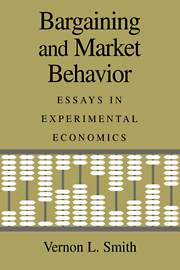Book contents
- Frontmatter
- Contents
- Preface
- Part I Economics and Psychology
- Part II Bargaining Theory, Behavior, and Evolutionary Psychology
- Part III Institutions and Markets
- INTRODUCTION
- 10 Reflections on Some Experimental Market Mechanisms for Classical Environments
- 11 Experimental Methods in the Political Economy of Exchange
- 12 Individual Rationality, Market Rationality, and Value Estimation
- 13 Market Contestability in the Presence of Sunk (Entry) Costs
- 14 The Boundaries of Competitive Price Theory: Convergence, Expectations, and Transaction Costs
- 15 Off-Floor Trading, Disintegration, and the Bid–Ask Spread in Experimental Market
- 16 Bertrand-Edgeworth Competition in Experimental Markets
- 17 An Experimental Examination of the Walrasian Tâtonnement Mechanism
- Part IV Stock Markets and Bubbles in the Laboratory
- References
- Index
13 - Market Contestability in the Presence of Sunk (Entry) Costs
Published online by Cambridge University Press: 29 October 2009
- Frontmatter
- Contents
- Preface
- Part I Economics and Psychology
- Part II Bargaining Theory, Behavior, and Evolutionary Psychology
- Part III Institutions and Markets
- INTRODUCTION
- 10 Reflections on Some Experimental Market Mechanisms for Classical Environments
- 11 Experimental Methods in the Political Economy of Exchange
- 12 Individual Rationality, Market Rationality, and Value Estimation
- 13 Market Contestability in the Presence of Sunk (Entry) Costs
- 14 The Boundaries of Competitive Price Theory: Convergence, Expectations, and Transaction Costs
- 15 Off-Floor Trading, Disintegration, and the Bid–Ask Spread in Experimental Market
- 16 Bertrand-Edgeworth Competition in Experimental Markets
- 17 An Experimental Examination of the Walrasian Tâtonnement Mechanism
- Part IV Stock Markets and Bubbles in the Laboratory
- References
- Index
Summary
The core of the contestable markets theory is the hypothesis that, with completely free entry and exit, a market that exhibits economies of scale – the traditional “natural monopoly” cost structure – will not exhibit monopoly behavior, even if only a single producing firm is observed in the market (Demsetz, 1968a; Bailey, 1980; Bailey and Panzar, 1980; Baumol and Willig, 1981; Baumol, 1982; Baumol et al., 1982). That is, in the absence of any other restrictions on entry and exit, scale economies alone do not constitute an effective barrier to entry. Coursey et al. (1983: hereafter CIS), have reported the results of a series of experiments in which each of two firms has identical decreasing marginal cost and the same capacity, but demand is insufficient to accommodate (profitably) any output in excess of the capacity of either firm.The conditions of these experimental markets further provide the “hit-and-run,” zero sunk costs (Baumol, 1982; Baumol et al., 1982) of the contestable markets hypothesis. In CIS, these results are compared with those from an uncontested market with one monopoly firm (i.e., a market in which sunk costs are effectively infinite for a potential entrant). The CIS experiments strongly support the contestable markets hypothesis, namely that to observe approximately competitive behavior by a single producing firm with substantially decreasing costs, it is sufficient that (a) sunk costs are zero and (b) there are two contesting firms acting noncooperatively in the sense that there is no explicit nonprice communication between them that leads to collusive restriction in supply. Furthermore, it is necessary that (c) the producing firm's market be contested by at least one other firm with the same cost structure.
- Type
- Chapter
- Information
- Bargaining and Market BehaviorEssays in Experimental Economics, pp. 265 - 285Publisher: Cambridge University PressPrint publication year: 2000



